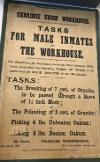Hospitals: Workhouse to Hillingdon Hospital
Hillingdon Hospital finds its origins as a Workhouse for the Uxbridge Poor Union in around 1838. Located to nearby Colham Green, the workhouse and hospital have occupied the same space for over 180 years.

By Victorian times the support of the state was only offered to those who chose to enter the workhouses, anyone who refused had to support themselves or face the consequences.
Life in workhouses was intended to be harsh in order to discourage the population from relying too heavily on the state when it came to healthcare, food and employment.
Jobs such as rock breaking would be a health-risk but also allowed some county councils to run their workhouses at a profit. It was unlikely that any of this profit was passed onto the inmates.
After George Wythen Baxter wrote a scathing report on the poor conditions and treatment in Northern workhouses, a major reform was rolled out across the country. As a result, the Uxbridge Union Workhouse opened in 1838.
This workhouse was almost a mini-town in itself, providing multiple services for its users. Alongside the hospital it helped the elderly, served as an asylum, a school and provided employment and accommodation. According to the Uxbridge Union Minute book, "inmates were given 12 oz of bread a day, 1.5 pints of gruel, a lunch of beef, potatoes, soup and suet pudding and a supper of cheese, butter and broth".
In 1919 the Poor Law administration was taken over by the Ministry of Health. The workhouses, for all their faults, had been the first attempt at nationalised health care and social welfare. It became increasingly important to take people out of this environment, especially where the idea of the workhouse was less applicable to certain users. Schools, hospitals, asylums, care for the elderly and unemployment were all going to be cared for away from the workhouse.
In 1930 Middlesex County Council took over the workhouse and changed the name to Hillingdon County Hospital. There was a very limited service in the beginning, with only 227 beds to serve the local population. There were very few staff and training and facilities were extremely basic. Even the sterilisation of equipment was cause for concern in the Regional Medical Officer's Report in 1930:
"The instruments are being sterilised by means of a naked gas burner in the actual operating room. This does not allow of consecutive operations being carried on, as an ether laden atmosphere may cause a disastrous explosion"
In 1931, the work of the nurses at Hillingdon Hospital was praised so highly that the hospital was recommended to the Nursing Council to become a full training school for nurses, which was granted. Lodgings were built for accommodation, as nurses were required to live and train on site and in 1932 the tennis court was rebuilt!
At the outbreak of the Second World War plans to upgrade the hospital were put on hold, although an extra 300 beds were created in an extension under the Government Emergency Scheme. In October 1940 the maternity ward was hit by a bomb, and despite major damage only two nurses suffered minor injuries.
There were still major problems at the hospital, and as the demand grew, the services were unable to keep up, as reported by Medical Superintendent, Dr W Arklay Steel in 1941:
"Without the establishment of adequate services further organisation and development of the hospital cannot be carried much further."
Conditions failed to improve during the war. Cluttered hallways, lack of storage, unprotected sterilisation units and shoddy building work, all combined with the constant threat of bombing and a continuous stream of patients made for a very stressful working environment. At the end of the war Dr. Arklay Steel paid homage to the staff in this report:
"There is no doubt that civilians bore much of the prolonged dangers of the war, and it now seems fitting to place on record the high standard of work; loyalty and powers of endurance and tolerance show by all members of staff who, by all their efforts, have enabled the hospital to be so well sustained."
In 1946 a newspaper article outlined the overcrowding, rats, leaks and overworked staff that had the potential to cause a great scandal. With this and further pressure from Dr Arklay Steel, plans were made to finally improve Hillingdon Hospital.
In 1948 the National Health Service was introduced and the management no longer rested with Middlesex County Council. Dr Arklay Steel again pushed for a new hospital to be built, but it wouldn't be until 1954 that the Ministry of Health would begin to break ground on rebuilding the hospital. In that time all the hospitals in the local area had been taken on as 'Satellite Hospitals' and would be used to take patients on that the larger hospital might not have the beds for.